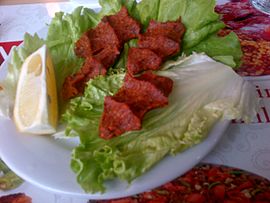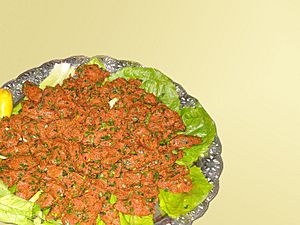Çiğ köfte facts for kids

Çiğ köfte meal in Turkey
|
|
| Region or state | mainly Urfa |
|---|---|
| Serving temperature | Lettuce or wrapped within tortilla with fresh lemon juice or pomegranate sauce |
| Main ingredients | Raw meat, Bulgur, onion, tomato paste, hot red pepper paste, urfa biber, salt |
| Ingredients generally used | Fresh mint, parsley, spice, lemon, olive oil |
| Variations | Vegetarian, Eggs |
| Similar dishes | Kısır |
Çiğ köfte (pronounced 'chee kuf-tah') is a special dish from southeastern Turkey, especially from a city called Urfa. It's a type of kofta (which means meatball). People often eat it as a starter or 'meze' (a small dish). It's quite similar to a Lebanese dish called kibbeh nayyeh.
You'll find Çiğ köfte in both Armenian and Turkish cuisines. Jewish people from Urfa also have it as part of their traditional meals.
Traditionally, Çiğ köfte is made with raw meat. However, there are also vegetarian versions. These are made with bulgur (a type of cracked wheat). In Urfa, some meatless versions even use scrambled eggs. In the city of Diyarbakır, you can buy freshly made batches from street vendors.
Contents
What Does Çiğ Köfte Mean?
In the Turkish language, çiğ means "raw." The word köfte means "meatball." So, Çiğ köfte literally means "raw meatball."
The word köfte comes from the Persian language. It eventually traces back to a very old language root that means "to grind" or "to pound."
In Aramaic, which is the traditional language of Edessa (modern-day Urfa), this dish is called Acin.
How Çiğ Köfte is Made
To make Çiğ köfte, first, bulgur is mixed and kneaded with chopped onions and a little water until it becomes soft. After that, ingredients like tomato paste, pepper paste, and various spices are added. Very finely ground beef or lamb is then mixed in. This raw, fat-free meat is kneaded with the spices. This kneading process helps to "cook" the meat.
Finally, fresh green onions, mint, and parsley are mixed into the blend. Some people, especially in a city called Adıyaman, don't use water in their recipes. Instead, they use ice cubes and lemons to help with the kneading.
Using Different Meats
If using beef, the meat is ground very finely. Any tough parts or fat are removed before grinding. It's important to use high-quality beef because it will be eaten raw.
Lamb is also a popular choice for Çiğ köfte. Both Armenians and Turks often serve Çiğ köfte with lamb as a cold meze. The raw lamb meatball is usually made and eaten on the same day. It's not kept overnight. The lamb must be deboned and have all tough bits and fat removed before it's prepared. For the best freshness, the lamb should be bought and prepared on the very same day it's butchered.
Whether using beef or lamb, very finely ground bulgur is always needed. Other common ingredients include mild onions, scallions, parsley, and often green pepper. Some versions might also use tomato sauce, hot sauce, or mint leaves.
When served, Çiğ köfte can be shaped into small balls or spread out on a plate. Sometimes, people eat it with crackers or pita bread.
Where Çiğ Köfte is Popular
In Turkey

Çiğ köfte is very popular in the Şanlıurfa Province of Turkey. It's a common street food there. However, it's also a popular appetizer all over Turkey. The ingredients are all raw. They traditionally include ground meat, bulgur, tomato paste, fresh onion, garlic, and other spices. A special spice called "isot" and black pepper are often used.
A favorite way to eat Çiğ köfte is rolled inside a lettuce leaf. People often drink a yogurt drink called ayran with it. This helps to cool down the burning sensation from the very spicy food.
There's also a vegetarian version of Çiğ köfte made only with bulgur grains. It's prepared in a similar way to the meat versions. Some cooks also add pomegranate molasses for a sweet and sour taste. Depending on what the cook likes, spices like cumin might be used instead of isot in vegetarian versions. Another vegetarian option from Urfa is made with scrambled eggs.
Even though the traditional recipe uses raw minced meat, the Çiğ köfte sold as fast-food in Turkey usually doesn't contain meat. This is because of health and safety rules. So, unless it's specifically made with meat, Çiğ köfte in Turkey is often vegan. In these versions, ground walnuts, hazelnuts, or potatoes are used instead of meat.
In Armenia
Çiğ köfte is considered a special dish in Cilician Armenian culture. It's usually prepared for special events and holidays. There are many different ways Armenian families make Çiğ köfte. This depends on where their family comes from and what they prefer. For example, some might use more or less bulgur, or more or less pepper paste, depending on how spicy they like it.
Traditional Armenian Çiğ köfte comes in two main forms. It can be shaped into loose meatballs, like small eggs. Or, it can be flattened on a plate with olive oil and minced green onions, similar to kibbeh nayyeh. However, unlike people in the Levant, Armenians usually don't eat Çiğ köfte with bread.
A vegetarian version also exists. It looks and feels very similar to the meat version. While it's made all year, it's especially popular during Lent. This is because of the diet rules of the Armenian Apostolic Church.
In the United States
Çiğ köfte was brought to the United States by Armenian immigrants. It is often called Armenian beef tartare there.
A Legend About Çiğ Köfte
There's a legend about how Çiğ köfte first came to be. It involves King Nemrut, who ruled an ancient kingdom in the Adıyaman region. The story says that King Nemrut wanted to burn Abraham because Abraham believed in only one god. The king ordered his people to gather all the wood in the kingdom into a large square. This meant no wood was left for cooking in people's homes, and fires were forbidden. The wood gathered was only to be used to burn Abraham.
One day, a hunter returned home with a deer he had caught. He didn't know about the king's order. He asked his wife to cook the deer. She told him about the king's rule against lighting fires. The hunter had to obey the order.
So, the hunter took the deer's hind leg and crushed it finely with a stone. He then added bulgur, black pepper, and salt. He kneaded it very well with the ground meat. It is said that this hunter and his family were the first to make raw meatballs, which became Çiğ köfte.
See also
Template:Kids robot.svg In Spanish: Çiğ köfte para niños

